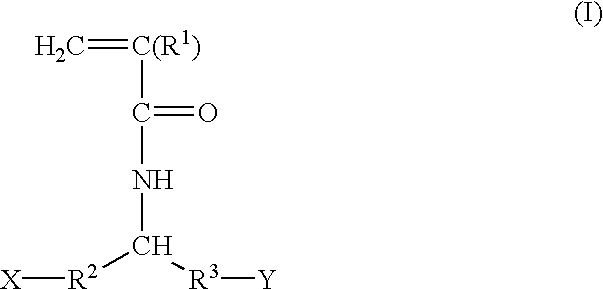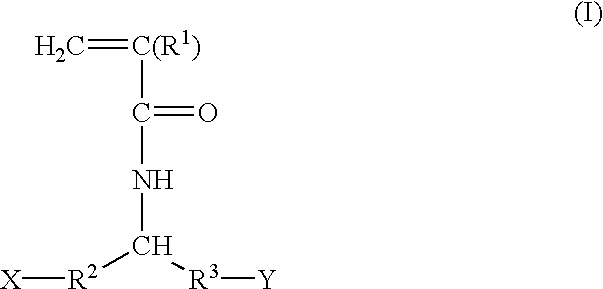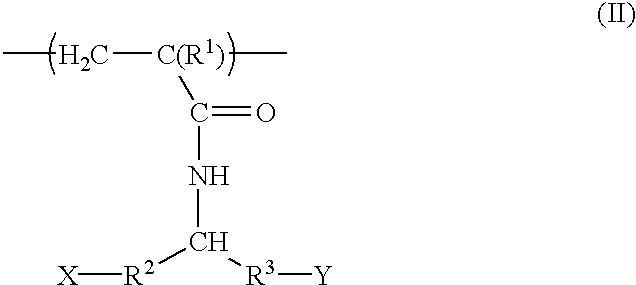Acrylamide derivatives and polymers containing said derivatives
a technology of acrylamide and derivatives, applied in the field of acrylamide derivatives and polymers containing said derivatives, can solve the problems of insensitive transition behavior, inability to introduce many functional groups into temperature-responsive polymers or hydrogels, and inability to meet the requirements of temperature-responsive polymers and hydrogels, etc., and achieve rapid polymerization and efficient initiation
- Summary
- Abstract
- Description
- Claims
- Application Information
AI Technical Summary
Benefits of technology
Problems solved by technology
Method used
Image
Examples
references examples 1 to 4
In 35 ml of tetrahydrofuran were dissolved N-isopropyl acrylamide (abbreviated as "IPAAm") and acrylic amide (abbreviated as "AAc") in respective amounts as described in Table 1 and 11.5 mg of azobisisobutyronitrile (abbreviated as "AIBN") as the polymerization initiator, deaerated, then sealed and stirred at 65.degree. C. for 2.5 hours. After the reaction, the precipitation of the reaction product into diethyl ether was twice repeated to effect purification.
reference examples 5 to 8
In a test tube N-isopropyl acrylamide (abbreviated as "IPAAm") and acrylic acid (abbreviated as "AAc") in respective amounts as described in Table 2, 26.6 mg of methylenebisacrylamide as the crosslinking agent and 48 .mu.l of N,N,N',N'-tetramethylenediamine as the polymerization promoter were dissolved in 10 ml of water. After the resulting solution was bubbled with a nitrogen gas, 200 .mu.l of a 40 mg / ml ammonium persulfate aqueous solution were immediately added thereto and then, the solution was drawn up in a capillary tube. The capillary tube was maintained at 0.degree. C. for 24 hours and then, a crosslinked product thus prepared was taken out of the capillary and dipped in cold water for one day to effect purification.
example 1
Synthetic Scheme of 2-(Benzyloxycarbonyl)isopropyl Acrylamide
##STR7##
According to the above synthetic scheme, first, 18.1 g of aminobutyric acid, 87.5 ml of benzyl alcohol and 40.0 g of p-toluenesulfonic acid were dissolved in 175 ml of benzene and refluxed. The water formed was removed as the azeotrope with benzene. To the reaction solution were added 280 ml of diethyl ether and 280 ml of hexane to form a precipitate. This precipitate was separated by filtration and recystallized in an ether / ethanol mixed solution to effect purification. As a result, 53.8 mg of .beta.-aminobutyric acid benzyl ester.multidot.p-toluenesulfonate were obtained as a white crystal. From the results of .sup.1 H-NMR spectrometry the synthesis of .beta.-aminobutyric acid benzyl ester.multidot.p-toluenesulfonate was confirmed. The results of the .sup.1 H-NMR spectrometry are set forth below. The underlined portion shows the position of the corresponding proton in the compound. Further, in the NMR data, ".PHI...
PUM
| Property | Measurement | Unit |
|---|---|---|
| phase transition temperature | aaaaa | aaaaa |
| temperature | aaaaa | aaaaa |
| temperature | aaaaa | aaaaa |
Abstract
Description
Claims
Application Information
 Login to View More
Login to View More - R&D
- Intellectual Property
- Life Sciences
- Materials
- Tech Scout
- Unparalleled Data Quality
- Higher Quality Content
- 60% Fewer Hallucinations
Browse by: Latest US Patents, China's latest patents, Technical Efficacy Thesaurus, Application Domain, Technology Topic, Popular Technical Reports.
© 2025 PatSnap. All rights reserved.Legal|Privacy policy|Modern Slavery Act Transparency Statement|Sitemap|About US| Contact US: help@patsnap.com



